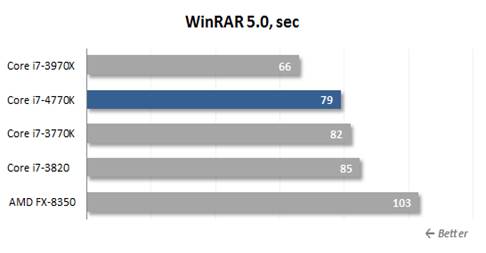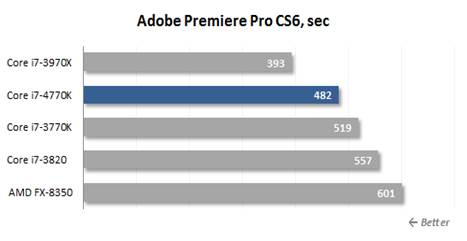Application
performance
In order to check the processor ability in
the process of data achieving, we use WinRAR archiving utility. For files with
the total size of 1.7GB, we use the maximum compressing rate.

WinRAR
5.0
The performances of Core i7 4770K and Core
i7 3770K, which represent two different types of microarchitectures, are almost
indifferent in the compression test. We hope to see faster L1 and L2 caches in
order to realize some positive effect of Haswell, but it must be good enough to
compensate for the increased latency of the L3 in this case.
The cryptographic process performance is
measured by using a built-in benchmark of popular utilities like TrueCrypt
using AES Twofish-Serpent “triple” encryption. This utility, we must say, not
only effectively loads any number of cores with work, but also supports special
AES instructions.

TrueCrypt
7.1a
All of the benefits of the new Haswell
microarchitecture are clearly explained by the 5% advantage of Core I 4770K
then Core i7 3770K (where both processors work at the same speed), but it is
not enough for the most senior LGA11500 CPUs to catch up with AMD Piledriver.
However, Intel fans would never be discouraged. The TrueCrypt cryptography is
just temporary when the eight-core AMD FX 8350 is faster than Core i7 4770K.
To check the audio transcoding speed into
mp3, Xilisoft Audio Converter 6.4 utility has been used. During this test, we
convert the audio albums which are saved as flac lose less format.

Xilisoft
Audio Converter 6.4
Mp3 files are compressed quickly by
Xilisoft Audio Converter. However, the Haswell processor fulfills this task
even quicker compare to the Core i7 3770K.
As the ninth version of the popular science
Wolfram Mathematica suite is available, we decide to bring it back as one of
our regular standards, so the integrated Mathematica Mark9 has been used in
this software to check for the system performance

Mathematica
Mark9
Not all of the computing conducting in
Mathematica can be split in parallel threads efficiently. However, Core i7
4770K reveals the advantage of up to 11% compared to the Ivy Bridge processor
when working at same clock rate and therefore even faster than the a
1000-dollar heavy-weight Core i7 3970.
We measure the performance in Adobe
Photoshop CS6 using our benchmark, which is made of Retouch Artists Photoshop
Speed Test in which we made some creative modification. It consists of typical
editing of four 24-megapixel image from a digital camera.

Adobe
Photoshop
Here, the new microarchitecture just shows
the increase of 6%. After two generations of processor, Intel is just able to
increase the performance in Photoshop 12%: this is the difference between the
testing scenarios running on Core i7 4770K and Core i7 3820. Unfortunately, this
is rather not enough to be considered as a reasonable argument for the benefit
of an upgrade.
We make some tests also in Adobe Photoshop
Lightroom 4.4. The testing scenarios includes after editing and exporting as
JPEG format of two hundred 12-megapixel RAW images.

Adobe
Photoshop Lightroom 4.4
The result for this is nearly similar to
that of the test in Photoshop. The performance of Intel’s quad-core processor
does not show a significant increase from the year of 2011, when Sandy Bridge
microarchitecture appears.
The performance in Adobe Premiere Pro CS6
is determined by the required time to render a Blu-ray project with a 1080p25
HDV movie into H.264 format and apply different special effects on it.

Adobe
Premiere Pro CS6
High definition video is one of the best
types of multi-core processors. Therefore, Haswell seems to have much advantage
in this aspect compared to other tests: more efficient Hyper-Thread technology
starts to be more important. However, the measured difference between the
performances of Core i7 4770K and Core i7 3770K still remains in one-digit
percent.
In order to measure the speed of the tested
models, we convert the video codes into H.264 format and then using x264 HD
Benchmark 5.0. It works with an original MPEG-2 video recorded at the
resolution of 1080p with 20 Mbps bit rate. We can say that the result for these
tests does have very significant practical meaning, as the x264 codec is a part
of other popular transcoding utilities, such as HandBrake, MeGUI, VirtualDub,
etc.

X264
HD Benchmark 5.0

X264
HD Benchmark 5.0
In H.264/AVC video, compared with the Ivy
Bridge CPU which working at same clock frequency, transcoding Haswell achieves
the highest performance boost. It is equivalent to 13%, making Core i7 4770K
faster than AMD FX-8350, which used to perform better in transcoding tasks. Therefore,
it seems that Haswell’s release has tried to take over the AMD processors’
position, making them less attracting to users. Obviously, AMD need to reduce
the price of Socket AM3+ processor once again.
We will check the computing performance and
the rendering speed in Autodesk 3ds max 2011 by using SPECapc, especially for
benchmark 3ds max 2011:

3ds
max 2011

3ds
max 2011
Rendering is an example of a multi-threaded
task. That is why we see a 15% advantage of the new processor compared to its
predecessors. The advantage of Core i7 4770K than Core i7 3820 even exceed 20%.
However, during the entire test, we hardly see any impressive performance
increase, which we have caught in the synthetic tests. Unfortunately, the
modern software still yet supports AVX2/FMA3 although FM3 suites have been
supported by AMD processors for more than one year.